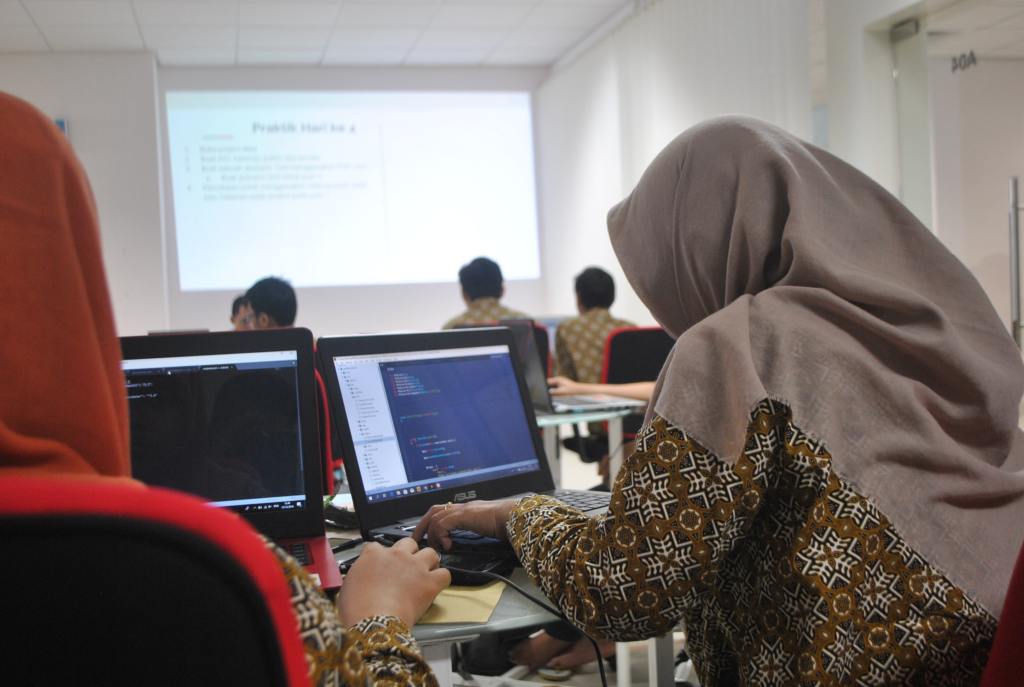Demand for computer science talent is soaring in the UK tech sector but our research shows that we still need more young people to consider this as their career to ensure the industry can continue to grow.
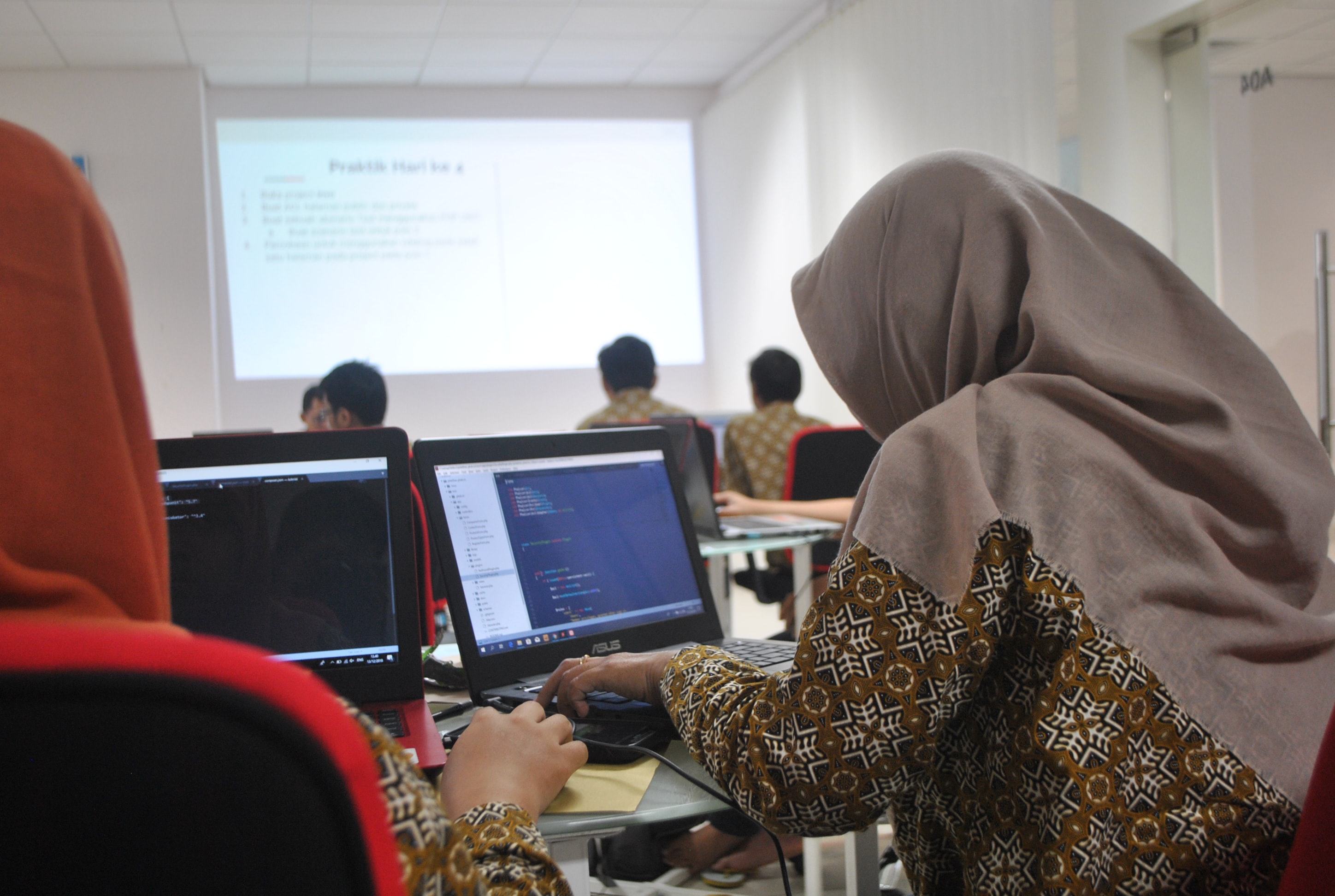
Computing really does underpin modern life, and the continuing success of the technology industry depends on the supply of talented people who have the crucial computing and problem-solving skills to enable progress, innovation and growth in this fast-changing field. But gaining access to that talent pool isn’t always easy, and as the industry grows so too does the number of qualified people needed to take on new roles.
We have recently done extensive research into the provision of computer science education in the UK, to determine if enough young people are engaging with this subject and being encouraged to consider it as their career while they’re at school.
This Computer Science in the Classroom report highlights that while the number of students sitting computer science courses at school and university has been growing, there is still a skills deficit and currently there are more jobs being advertised than there are qualified people to fill them.
Read on to find out more.
2022 Results Update
Our last Computer Science in the Classroom report research was carried out in Summer 2021.
With news that the UK is facing one of the biggest digital skills shortages in recent years, we decided to delve into GCSE, UCAS and job market data once again, to find out if and how the situation has changed over the course of the past year, and what this could mean for the booming tech market.
The UK is facing an “all time high” tech skills shortage
The UK tech sector has been thriving in recent years, but multiple reports claim the country is currently facing a massive digital skills shortage and companies are struggling to find STEM talent to fill their vacancies.
Research by Coursera reports the UK tech market has seen record levels of investment in four out of the past five years, with the country’s market showing particular strength in AI, biotech, cyber security, and fintech.
It’s undeniable the industry has been going from strength to strength, but experts are now claiming the UK market may risk lagging behind other countries due to the supply of specialised skills not meeting the ever-growing demand.
In fact, according to industry coalition FutureDotNow, a huge chunk of the British workforce is not skilled enough to apply for tech-related jobs. What’s more, as reported by the BBC, around 11.8 million workers in the country currently lack basic digital skills, let alone more complex ones.
And this is affecting recruitment for thousands of companies nationwide. Another report by TechNation states tech job vacancies are at a 10-year high as companies struggle to find talent with the right skillsets. It’s been reported The UK Commission for Employment and Skills disclosed earlier this year that 43% of STEM vacancies were not being filled due to a shortage of applicants, leaving tech skills in even higher demand compared to previous years. Naturally, in order to bridge the skills gap it’s vital that young people are encouraged into tech careers, and are given the necessary training and education.
Salary prospects grow as companies hope to attract tech talent
Last year, our analysis showed there were 11,360+ jobs across the UK that specifically referenced ‘computer science’ skills and qualifications, with an average advertised salary of £53,857 – this was 36% higher than the national average advertised salary of £39,715, demonstrating just how sought after this skillset is.
The number of vacancies in this category was also 91% higher than it was in 2020, illustrating how this area of the technology sector has been booming.
In the last year, vacancies for computer-science related jobs have grown by a further 281% year-on-year, reaching 43,343+ as of August 2022. The average advertised salary for these currently stands at £39,781 in 2022, 12% more than the national average advertised salary of £35,511.
In 2022, salary prospects for entry-level roles remain really promising and have grown significantly for some roles. For example, the current average salary of a graduate software engineer standing at £35,296 (+17% compared to last year), over £15k more than a teaching assistant (£19,632) and £9k higher than a marketing graduate (£26,710), signalling companies may be offering higher salaries to try and attract talent with the right skillset amongst the growing shortage.
With this in mind, we’ve also revisited data on the number of young adults studying Computer Science, as this could imply if the skills gap may be plugged by incoming new talent in the coming years.
The number of students sitting Computer Science is growing, but not nearly enough to bridge the gap
Our previous analysis highlighted that despite the number of Computer Science students at GCSE and higher education level being on the rise, supply for skills wasn’t yet meeting demand in the ever-growing UK tech sector in the past few years. This year, it appears the gap may be widening.
Our new analysis found the number of students sitting Computer Science GCSEs has risen again this summer, but not nearly enough to help bridge the current skills gap. In fact, the figures showed just a 1% year on year increase in the number of students sitting computing/computer science at GCSE level this year – rising to 81,120 in 2022 from 79,964 in 2021.
However, when comparing the current data to that of 2014, the oldest records available, the figures show the number of students taking these subjects at GCSE level has seen a staggering increase from 16,773 to 81,120, a +383% rise.
A similar picture can be painted at Undergraduate level. As part of our previous research, we sourced and analysed UCAS applications data for Computer Science under the subject group JACS3.
UCAS reporting criteria for applications to specific subject groups have changed this year, meaning statistics by subject group (JACS3), which included Computer Science specifically, are no longer published as part of UCAS public data releases.
For this reason, we weren’t able to source and compare 2022 data for Computer Science (JACS) with previous years. However, the number of applications for Computing subjects under the HECoS classification from 2019 to 2022 (June deadline, the latest available data) are available.
The figures show applications for Computing-related courses have continued to increase year-on-year. The latest available UCAS data shows there were a total of 179,600 applications for Undergraduate Computing courses in June 2022, 16% more than in 2021 (155,290). When comparing these to 2020 and 2019 figures, the increase is even more evident.
In 2022, there were 17% more applications for computing courses compared to the same time in 2020, when the figure stood at 153,480 for the June deadline, and 20% more compared to 2019, where the total number of computing applications stood at 149,350.
But despite the growth in popularity of the subject achieved in the past few years, there is still more work to do to engage students at all levels and inspire the tech workforce of tomorrow.
Female students are still being outnumbered, but the popularity of computing-related subjects is growing amongst young girls
The disparity between the numbers of male and female students sitting Computer Science at GCSE and enrolling at Undergraduate level remains high.
In 2022, 63,856 of the 81,120 students who sat the Computer Science GCSE were male (79%), and just 17,264 (21%) were female. Encouragingly, though, this year represented the largest cohort of female students sitting this GCSE since records began in 2014, and a 4% increase over 2021’s figures (16,549).
In comparison, the number of boys sitting this course increased by just 1%, suggesting the popularity of the course is growing faster year-on-year amongst female students.
When looking at figures for computing-related undergraduate degrees, male students continue to outnumber female applicants, with a total of 144,890 young men (80% of the total) versus just 34,710 (20%) women.
Encouragingly, though, the number of female applicants has increased by 20% year-on-year, considering the number of girls applying for computing-related degrees at the same time in 2021 stood at 28,910.
Overall, the data for 2022 has shown the popularity of Computer Science courses continues to grow, especially amongst female students. However, the tech skills gap the UK is currently facing has further increased the need to engage students at all levels, to ensure the industry has access to the right talent. Not only this, but it can represent a huge opportunity for educators and industry experts alike to further highlight the importance tech skills have in the workforce of tomorrow.
2021 Results Update
Our original Computer Science in the Classroom report research was carried out in Spring 2021. However, we decided to refresh the data again in August 2021, following the release of the latest UCAS and GCSE results, to see if and how things had changed in the last year.
We found out that the number of students undertaking Computer Science courses at GCSE and undergraduate level had risen again, according to the new 2021 data. This indicates that the industry’s united drive to engage young people in computing careers is paying off, which is so encouraging to see.
An additional 1,500 students sat the examinations at GCSE level this summer than in 2020, according to Joint Council for Qualifications figures.
The growth in student numbers is only marginally higher as a percentage though (2%), showing that we mustn’t lose momentum now, and there is still more work to do in increasing the popularity of this subject area.

That said, the progress made so far is very positive. We discovered that since 2014, when the first examinations took place for this course, the total number of students sitting the Computing GCSE has risen by an enormous 377% – from 16,773 to 79,964 in 2021.
The number of female students sadly remains low overall, at just 21%, but this has also grown significantly (by 544%) from 2,568 in 2014 to 16,549 this summer.
Regionally, Ofqual data revealed that Rutland, Bedfordshire, Buckinghamshire, and Gloucestershire have seen the biggest increase in GCSE Computing students over the last three years.
Some areas had seen a decline in interest. Student numbers for this course were quite down in Lincolnshire (-25% in 2021 versus 2018), Derbyshire (-19%), South Yorkshire (-18%), Cumbria (-17%) in particular. This data suggests that these areas may be suitable for a targeted student engagement drive in the coming months and years.
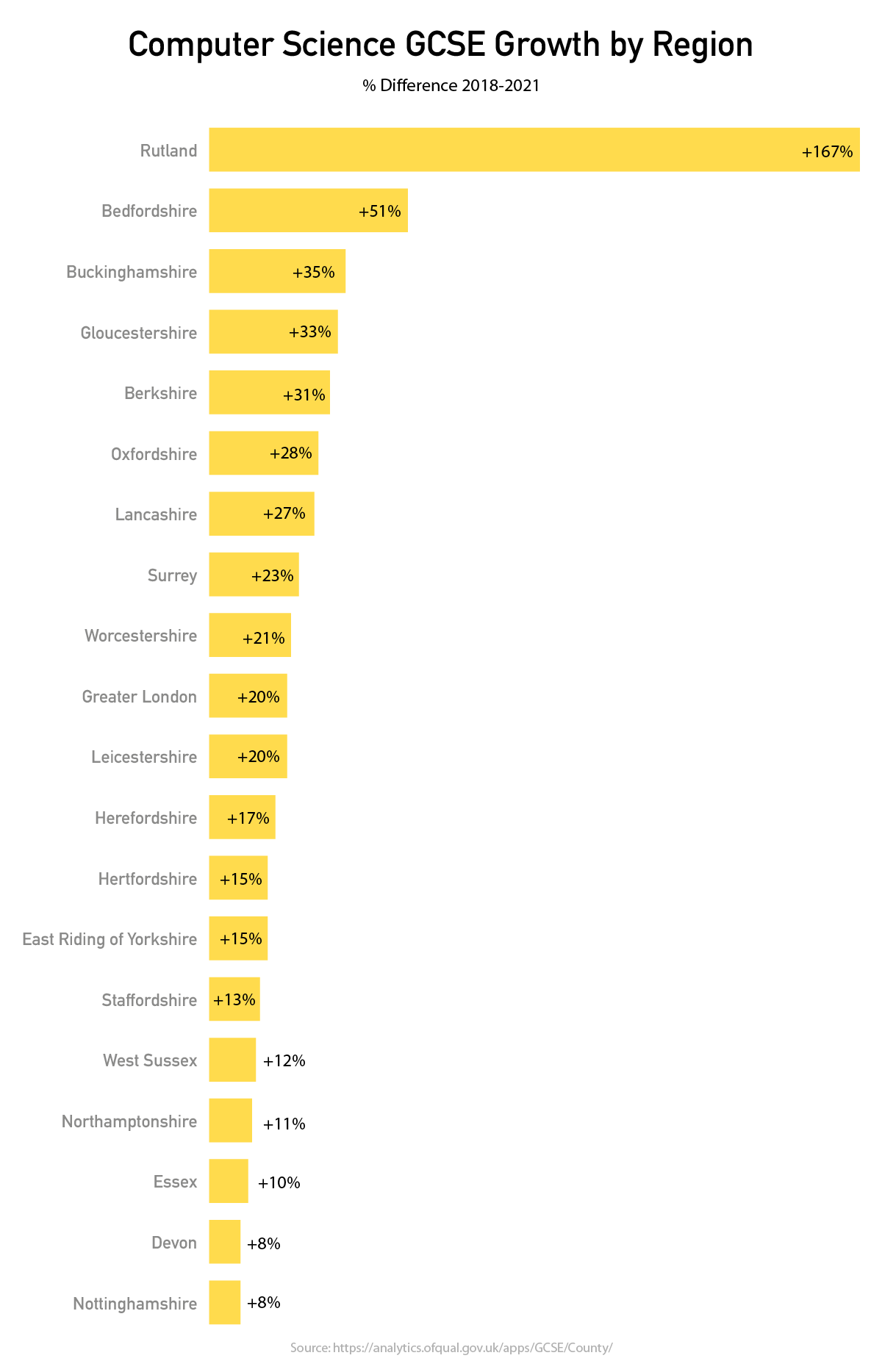
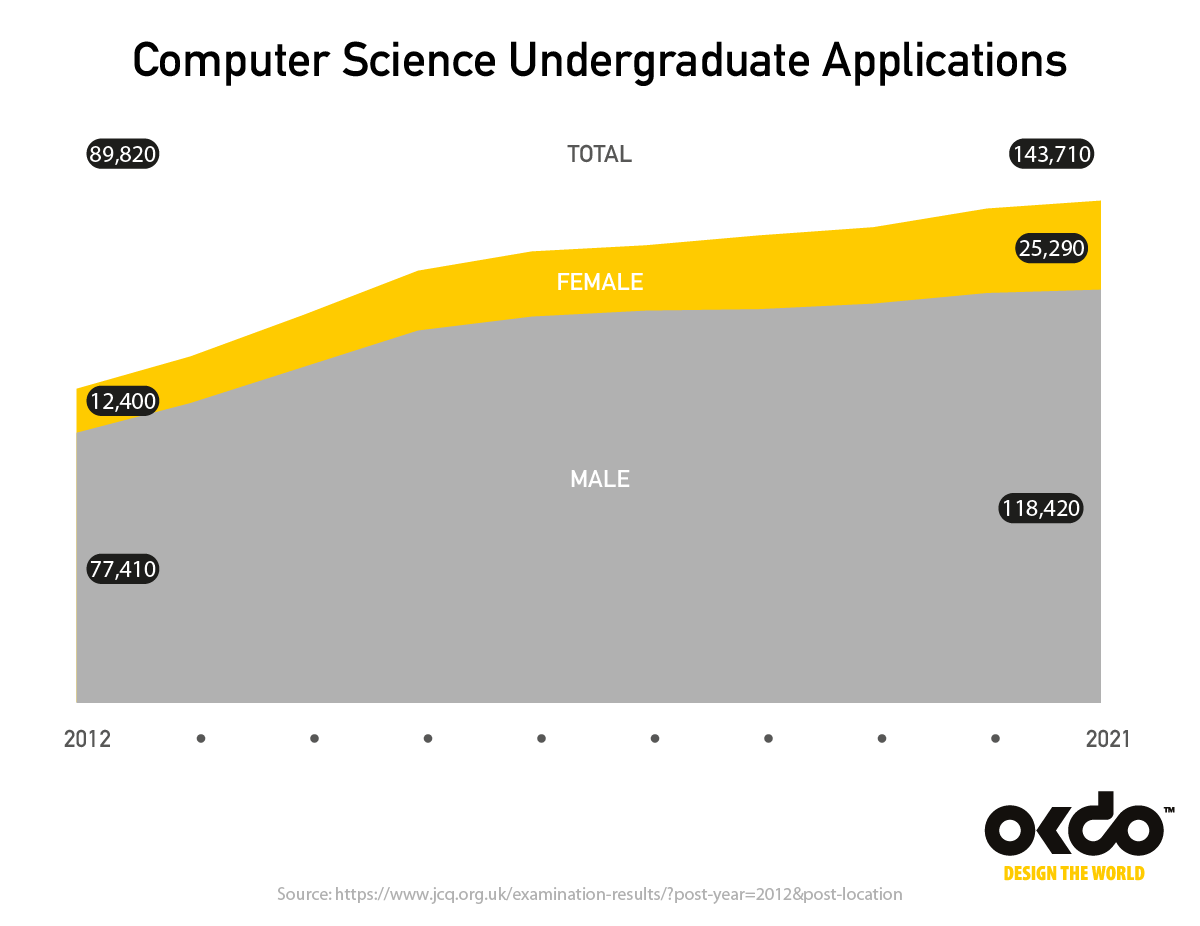
At undergraduate level, a similar rise in interest was reported by UCAS, with applications for Computer Science courses also up (2%), from 141,400 in 2020 to 143,710 in 2021. This figure doesn’t show accepted application numbers, so it isn’t completely reflective of how many computer science graduates we can expect in roughly three years’ time, but it is another encouraging sign that interest in this subject is still on the rise, albeit only marginally.
Women represented just 18% of the applicants this year, however the increase in students is higher amongst females in 2021 (up 5% versus 2020) than it is amongst males (up less than 1%).
Computing courses were found to be most popular amongst young students, with UCAS applications from those aged 30 and over down 3% year on year, despite the Coronavirus pandemic causing nationwide job losses that have led to many retraining in new careers.
Overall, the 2021 data is reassuring but continues to demonstrate the ongoing need to engage more young adults in this subject area, to ensure the growing tech sector has access to sufficient talent in the coming years.
Computer Science on the Curriculum
Since the new course and curriculum was launch in 2012, the number of students sitting the Computer Science GCSE in England, Wales, Scotland and Northern Ireland has steadily increased; from 16,773 students in its first year of assessment (2014) to 78,459 in 2020.
However, this still only represents about 1.4% of all GCSE’s sat.
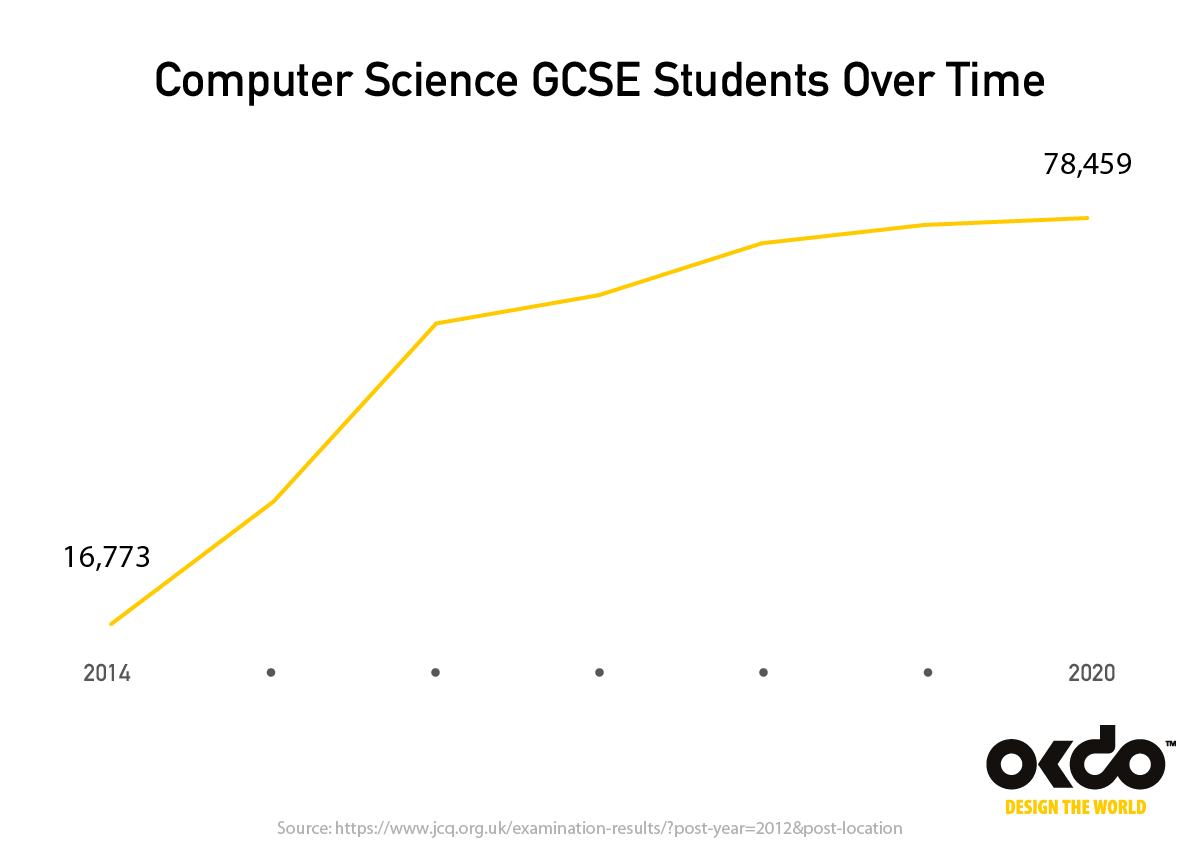
It is however currently the fourth most sat STEM subject at GCSE level, following Mathematics, Science (including the Double Award) and Physics, and it is also more popular that the traditional ‘ICT’ GCSE – only 9,345 students in the UK sat this in 2020 down from 111,934 in 2015.
Regionally, the highest number of Computer Science GCSE students in 2020 were located in Greater London (12,480), followed by Greater Manchester (4,185), the West Midlands (4,015) and West Yorkshire – including Leeds (2,575). Rutland (70), Herefordshire (185) and the Isle of Wight (190) had the fewest students sitting this GCSE option.
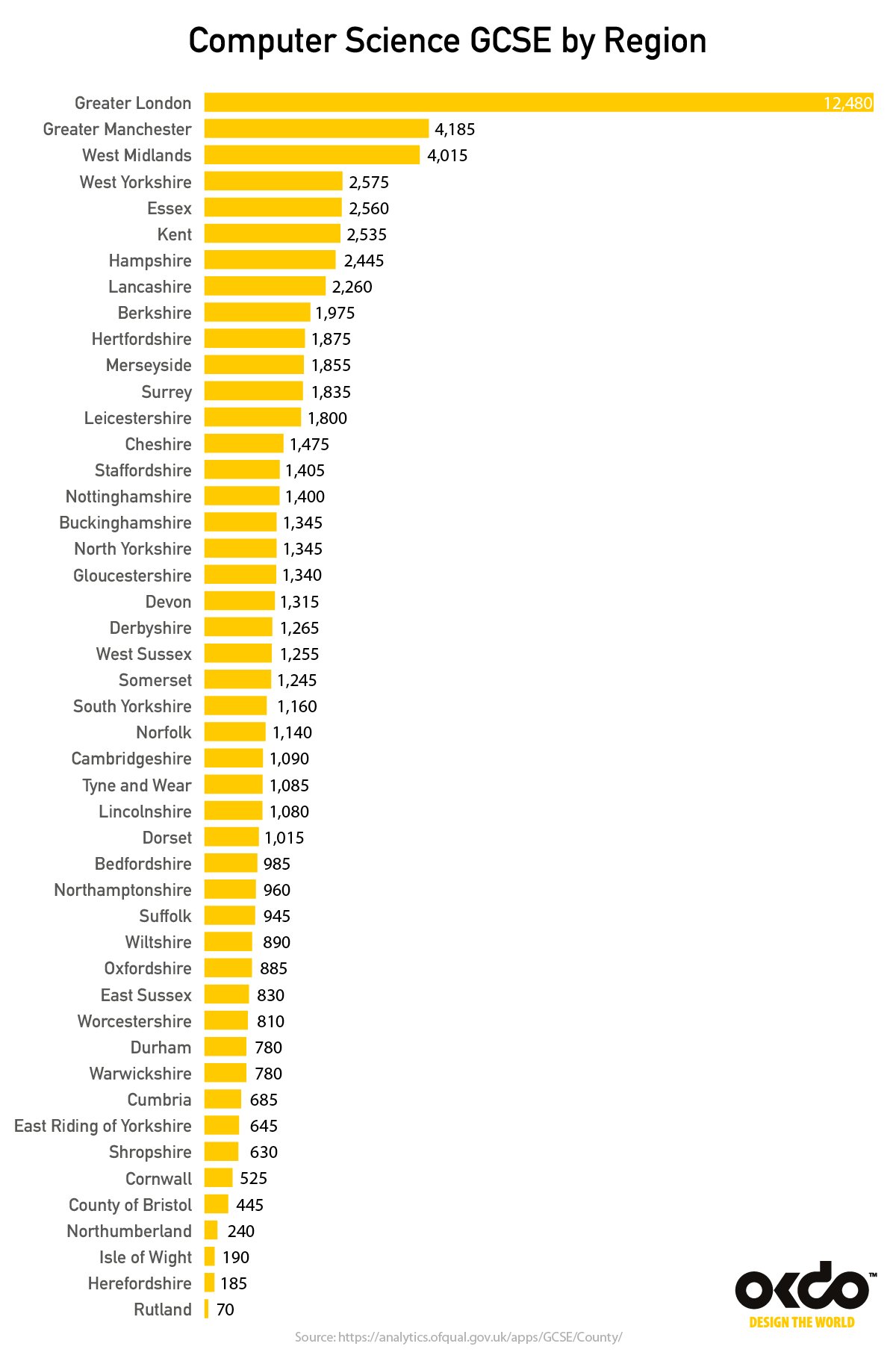
Engaging Female Talent Is Key
As it stands, the vast majority of students completing the Computer Science GCSE course are male.
Despite a rise of 544% in the number of female students choosing this subject at GCSE level (up from 2,568 in 2014 to 16,549 in 2021), the overall engagement of young women in this subject remains low. Just one in five (21%) of the 79,964 students sitting the Computer Science course in 2021 were female and there were 2% fewer female students in 2021, suggesting that more work is required to engage young women in this subject specifically.
Looking at higher education data, the number of female students doesn’t rise hugely. Data from Undergraduate UCAS accepted applications shows just 3,200 (16%) of female students were admitted into Computer Science courses in 2020.
However, this figure has seen an increase since 2019, when just 2,790 applications by female students were accepted, showing progress is slowly being made.
Further analysis of new NOMIS data also revealed the number of women currently employed in STEM jobs is still below half in most instances. Men still hold most of the jobs across major STEM-related professions in the UK, with the exception of biological scientists, where the percentage of female employees reaches 52%. In some professions, such as IT engineering, the percentage of women employees is as low as 3%, meaning only one in 33 employees in this sector is female.
STEM professions with the lowest percentage of female employees:
- IT engineers: 3%
- Electrical engineers: 7%
- Civil engineers: 9%
- Mechanical engineers: 10%
- Electronic engineers: 11%
- IT directors: 12%
The research shows the industry’s united drive to engage young people in computing careers is slowly paying off. However, more needs to be done to encourage young girls to pursue STEM careers.
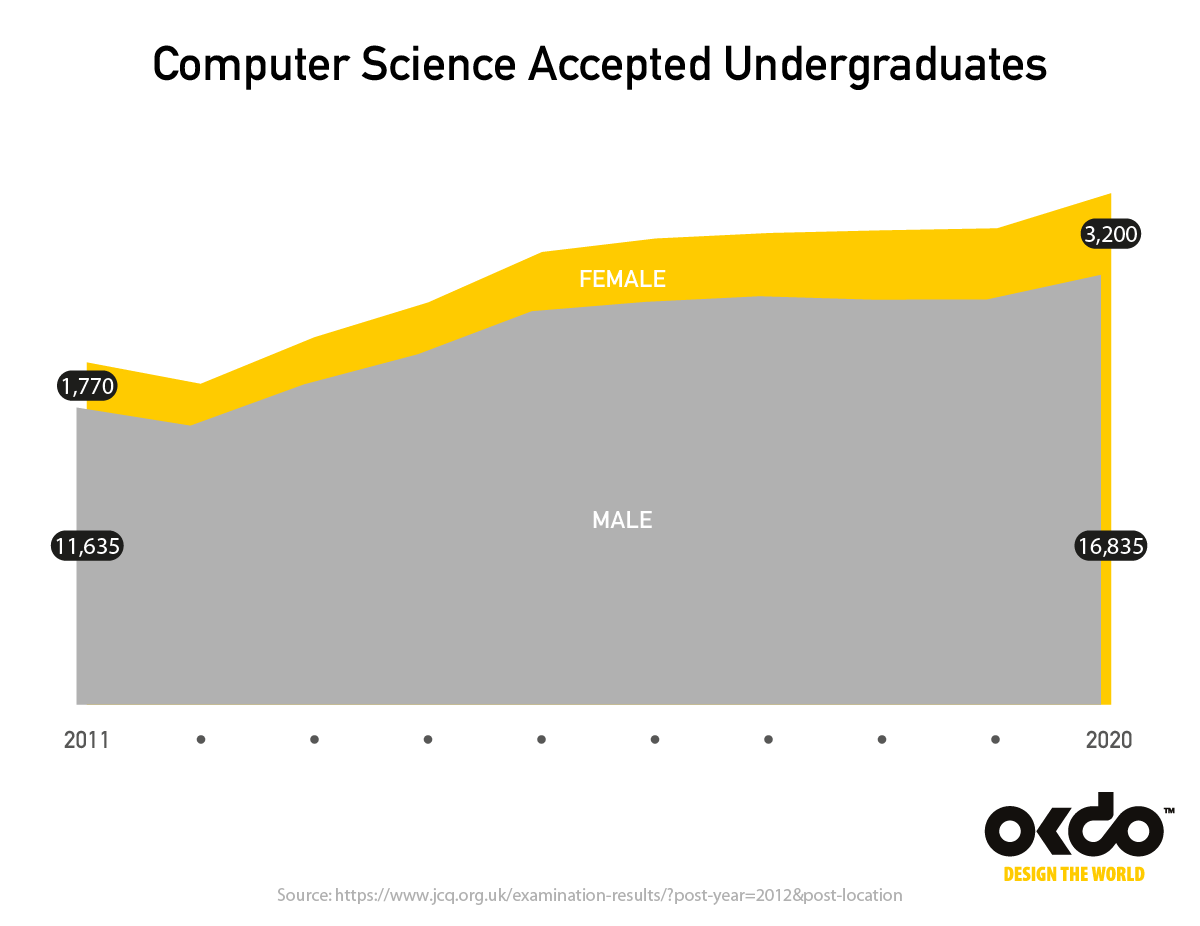
While female student numbers are low, those that do engage with this subject are typically doing very well. According to GCSE results data from the Joint Council for Qualifications, more female students have been consistently achieving higher grades in the Computer Science GCSE than their male counterparts. In 2020, two in five (41%) of the female students that sat this were awarded a grade of 7+, equivalent to an A or A* in the previous grading system, while this was the case for just under a third (32%) of male students.
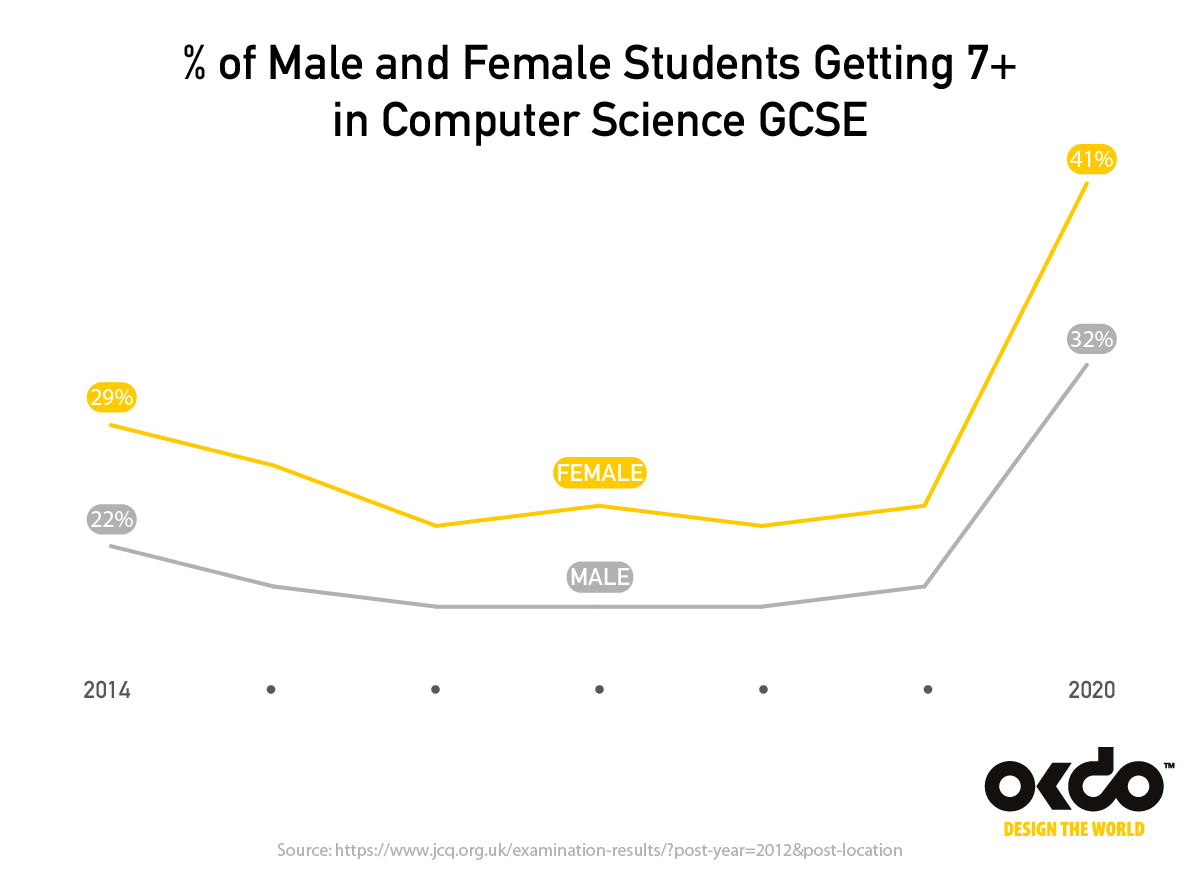
This pattern of excellent has been consistent since the curriculum’s implementation in 2014 and is also reflected in other STEM subjects such as Biology, Chemistry, Engineering, Science and Physics. In the past decade, the only STEM subject in which more male students have consistently earned higher grades than their female counterparts was Mathematics.
Supply of Skills Isn’t Meeting Demand
Computer Science GCSE attendance has grown by 367% since the curriculum’s implementation, and UCAS accepted applications for Computer Science courses have risen by 49% since 2011, with figures increasing from 13,405 to 20,035 in 2020.
But despite the number of Computer Science students at GCSE and higher education level steadily on the rise, it appears supply for skills still isn’t meeting demand in the ever-growing UK tech sector.
In April 2021 there were more than 40,000 open job adverts that require related skills and qualifications. These represent over 4.21% of all ‘open’ roles in the UK, which stood at around one million (956,049).
According to job vacancies data from Adzuna, the Covid-19 pandemic hasn’t held back the UK tech sector. The number of advertised tech-related roles slightly dipped in April 2020, at the beginning of the pandemic, but has already recovered and is back to pre-Covid levels. In some instances, demand for jobs requiring computer science related skills is at near-record level.
On average, advertised salaries for some of the most common computer science careers are considerably higher than average too, standing at £42,023 at the start of April 2021, versus the £35,444 of the general UK average.
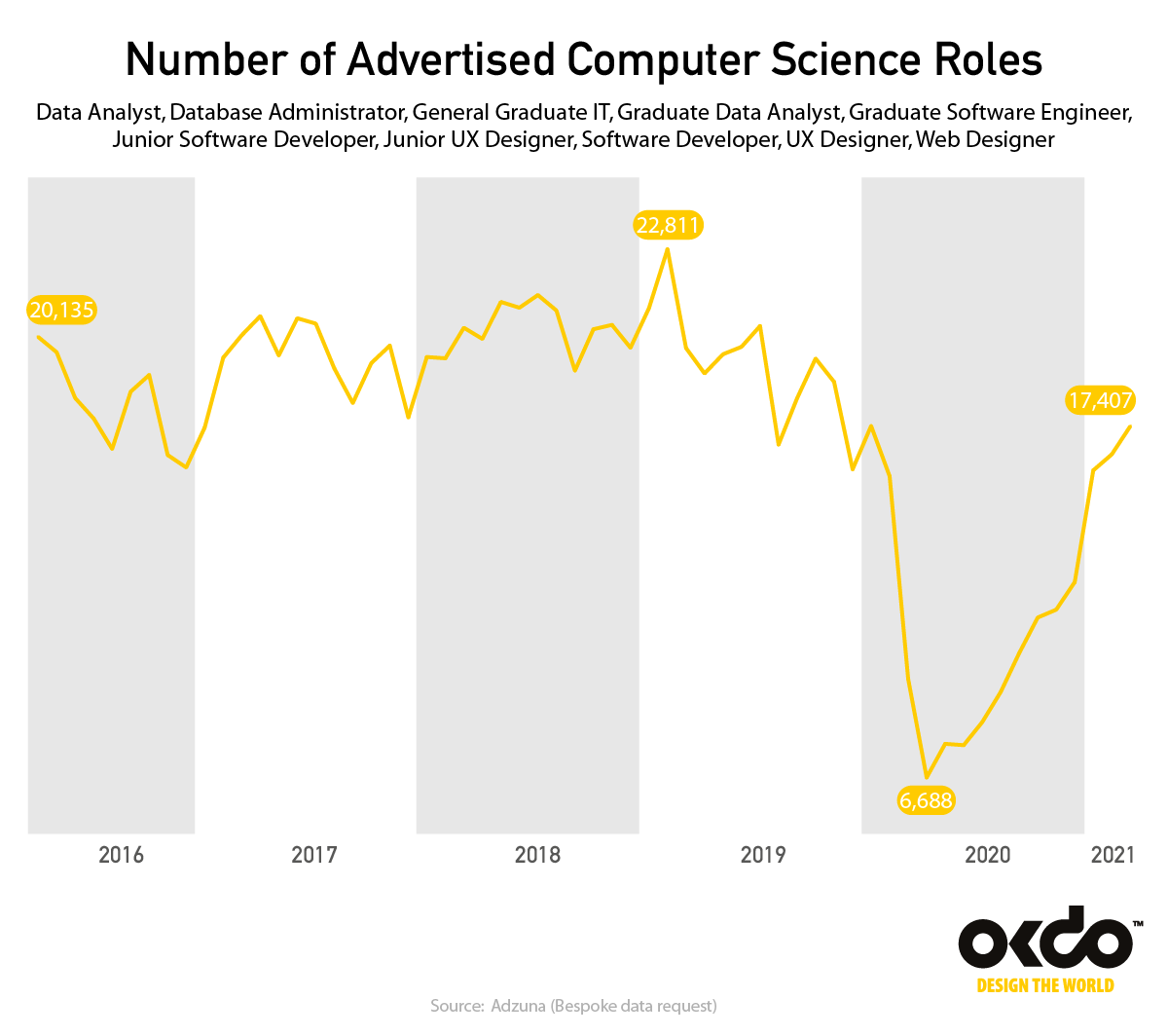
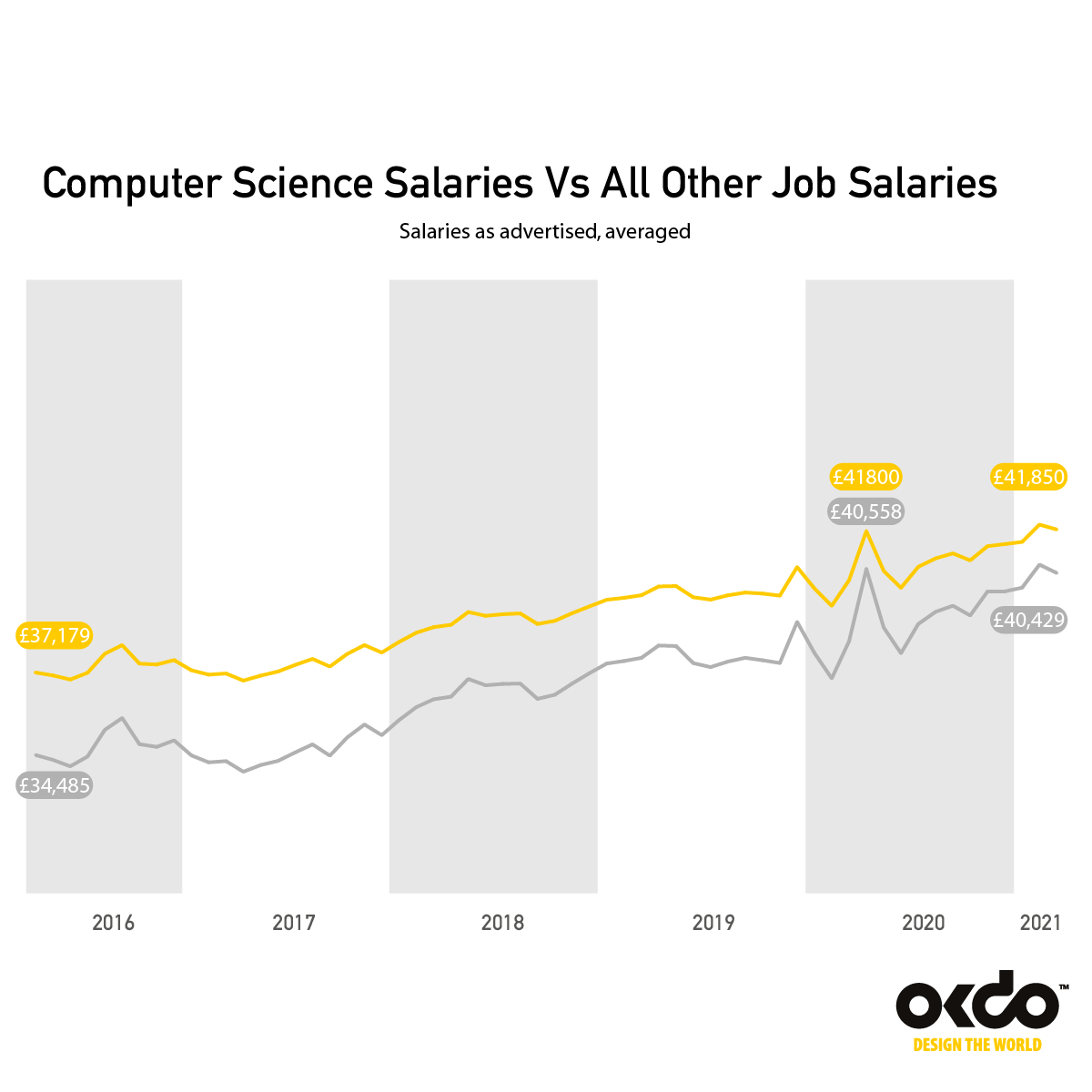
Computer science graduates can earn a considerable amount more than candidates at the same level in different sectors too. According to Adzuna data, the average prospect salary for a graduate software engineer jobs is £48,787, which is £20,000+ more than a marketing graduate (£26,454), Paralegal (£22,803) or teaching assistant (£19,802).
This has also grown over time. The average salary for this position started at £25,383 in 2016, suggesting that as opportunities in the sector have grown so has the salary.
A skills shortage could have pushed businesses to raise their salary offers to attract talent. The same can be said for many other roles that typically require computer science skills, such as a web designer, software developer and data analyst.






Julia Adamson, Director of Education at BCS, the Chartered Institute for IT, said “Computing provides great career opportunities to young people. We’ve seen increasing numbers studying it; including a 400% increase in students choosing AI degrees, as well as more teachers developing the subject knowledge and expertise to deliver an inspiring curriculum thanks to the support of the National Centre for Computing Education, launched in 2018. Great progress has been made, but more needs to be done, especially to encourage more girls and those from under-represented groups”
Andrew Hunter, Co-Founder of job search engine Adzuna, comments:
“The last few months have seen a surge in hiring for Tech and Digital roles, with the sector taking on staff at near-record volumes. Software Developers are in particular demand, accounting for over 1 in 100 of all the job ads currently on offer within the UK. There are also over five thousand Web Designer and Data Analyst roles lying open. The tough ask for employers is finding the skilled talent to meet this growing need. We urgently need to focus on upskilling and retraining the workforce into Computer Science-related roles to serve the swelling Tech sector and support even more future job creation.”
But high salary offers could still not be enough to attract female talent. According to a recent Kaspersky report on Women in Tech, 38% of women claim a lack of female representation in the sector makes them wary of entering the industry. Furthermore, just one in three (33%) women in a tech role were encouraged to learn IT skills at their school, college or university.
In Conclusion

Nicki Young, President of OKdo added: “Our research highlights just how important it is that the number of students studying computer science at GCSE and beyond – and choosing this as a career – continues to gain momentum. The tech industry has been reliably growing, and there is high demand for talented people with this specific skill set.
“I hold a computer science degree and know from experience that even at an entry-level, those coming into computer science roles are required to have a solid foundation of knowledge and expertise that is typically acquired through education. This in turn is reflected in the high entry-level salaries. Getting more young students engaged in this subject early on will be key to enabling this industry’s continued growth, alongside the retraining of people looking for a fresh challenge in a thriving sector.
“Progress has been made, but there is more work to do to really engage the tech talent of tomorrow. A Data Analyst, a Software Developer, a Web Designer – these should be aspired careers. This is particularly important amongst female students who are still studying STEM subjects in low numbers but have proven themselves to be highly capable; typically achieving higher grades than male students. I have led a large technology outfit with 100s of members, as a result, I have been fortunate to have worked with some incredible women in tech, but there are still too few, and it is something I have always been passionate about addressing. What attracts young women into a career in tech may be different in some instances from what appeals to male candidates, with the Kaspersky report implying that visibility of the positive societal impact of IT careers is more likely to attract women into the industry than a higher salary. “
“We all have a responsibility to do more to showcase role models women in Technology and all areas of STEM to inspire the next generation.”
Nicki Young
Do you want to get started with coding?
Visit our Project Hub for inspiring guides that show you how to build and program cool NVIDIA, Raspberry Pi, and Arduino projects using a variety of popular boards, kits, and tools.
If you are just starting out with Raspberry Pi, Arduino or another popular platform or tool, our getting started guides can help you do just that.
Sources
- Department for Education (https://form.education.gov.uk/service/Contact_the_Department_for_Education). An FOI request was submitted on 19.04.21 to request information on the number of students who have sat the Computer Science GCSE since it was started in 2012. The Department for Education is the UK government department responsible for child protection, education, apprenticeships and wider skills in England.
- Joint Council for Qualifications (https://www.jcq.org.uk/examination-results/?post-year=2012&post-location=). We downloaded all available data on all UK Computer Science GCSE students and results from 2012 – 2020. The Joint Council for Qualifications is a membership organisation comprising the eight largest providers of qualifications in the UK.
- Ofqual (https://analytics.ofqual.gov.uk/apps/GCSE/County/). We downloaded all available data on Computer Science GCSE results by region from 2018-2020. The Office of Qualifications and Examinations Regulation is a non-ministerial government department that regulates qualifications, exams and tests in England.
- Adzuna (https://www.adzuna.co.uk/jobs/salaries).We pulled data on average salaries by role, and number of open roles from Adzuna. They also supplied us with historic data on job numbers, salaries etc. Adzuna is a search engine for jobs ads used by over 10 million visitors per month that aims to list every job, everywhere. It searches thousands of websites, so users don’t have to, bringing together millions of ads in one place.
- UCAS (https://www.ucas.com/explore/subjects/computer-science and https://www.ucas.com/data-and-analysis/undergraduate-statistics-and-reports/ucas-undergraduate-sector-level-end-cycle-data-resources-2020). We pulled a list of careers related to computer science from UCAS. We also pulled data on accepted applications for Computer Science undergraduate courses. The Universities and Colleges Admissions Service is a UK-based organisation whose main role is to operate the application process for British universities.
- Prospects.ac.uk (https://www.prospects.ac.uk/careers-advice/what-can-i-do-with-my-degree/computer-science). We pulled a list of careers related to computer science from Prospects.ac.uk. According to their website, it is the UK’s biggest graduate careers website based on the number of monthly visitors and roles listed.
- BBC (https://www.bbc.co.uk/news/education-48993830). Information on the new GCSE grading system was pulled from here.
- ONS (https://www.ons.gov.uk/employmentandlabourmarket/peopleinwork/employmentandemployeetypes/datasets/ employmentbyindustryemp13). Data on the number of women working in tech roles in 2021. The ONS is the UK’s largest independent producer of official statistics and the recognised national statistical institute of the UK.
- Kaspersky (https://media.kasperskydaily.com/wp-content/uploads/sites/92/2021/02/15054851/Kaspersky-Women-in-tech-Report_UPD_Regional-Stories.pdf). We pulled some stats from the Women in Tech report that was published in February 2021.
